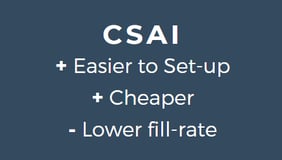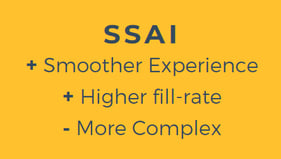Share this
CSAI vs SSAI: 4 Technical Things to Consider
by Mathias Craps on February 18, 2021
THIS IS A SNIPPET FROM OUR “CSAI VS SSAI: BEST BANG FOR YOUR BUCK” GUIDE WHICH YOU CAN DOWNLOAD HERE.
Previously, we’ve covered the differences between Client-Side and Server-Side Ad Insertion. In this article, we will talk about the technical things to consider when deciding between them. You can find a more in-depth explanation of this in the “CSAI vs SSAI: Best Bang for Your Buck” guide.
Transitioning between contents and ads
Switching between content and ads is relatively easy for CSAI ads, because most platforms allow the use of multiple decoders at the same time. A player could then load the content in one video element and preload the advertisement in another one. In practice, it is slightly more complicated. Real-world environments are complex and diverse.
 CSAI without Ad Preloading
CSAI without Ad Preloading

CSAI with Ad Preloading
Playing video advertisements during live-streams
In video-on-demand use-cases, it is easy to indicate when a CSAI video advertisement should play. For live streams, it is slightly more complicated for a variety of reasons:
- VMAP has been mainly designed with VoD use-cases in mind, leaving much room for interpretation with regards to signalling an ad opportunity in a live-stream.
- It is unclear whether content missed by playing an ad should be skipped after resuming, or picked up at the same time. It is preferable to skip the missed content and stay at the live point of the stream, but this comes at the cost of missing a bit of content.
.png?width=564&name=SSAI%20vs%20CSAI%20visual-04%20(1).png)
- Main content is paused during ad playback, making it challenging to get timed metadata from the live stream while playing ads.
Interactive Advertisement
Interactive advertising allows direct engagement between the advertiser and the end-user, as it can deliver a more interesting, dynamic ad experience.
Traditionally, CSAI has been stronger on this front, due to the VPAID specification. Up until 2019, there was no SSAI-counterpart for the popular CSAI-specification. With the release of VAST 4.2 and SIMID/OMID as the successors of VPAID, this shortcoming is now solved, as SIMID is compatible with Server-side ads.
The change in design through SIMID allows the player to reuse
the same interactive layer for both CSAI and SSAI ads.
The key factor to look out for is adoption: SIMID is relatively young and still needs to find its place in the market. Google DFP already started supporting this specification via its Google IMA-library.
Canvas or WebAudio
APIs such as canvas and WebAudio are not always considered when using Client-Side Ad Insertion approach. This is partly due to vendor limitations. For instance, Google IMA, the most dominant framework, renders its own ads in an iframe. This makes it impossible to connect these APIs. Since SSAI are always in stream, it is unlikely that you will face this problem with any SSAI-provider. Generally speaking, SSAI has these APIs out of the box while CSAI will entail more limitations.
WebAudio
Both Client-Side Ad Insertion and Server-Side Ad Insertion have their advantages and disadvantages. CSAI is generally easier to set-up, but comes with a generally lower fill-rate due to ad blockers and platform limitations.


SSAI is a bit more complex to set up, and slightly more expensive, but it provides an overall smoother experience. If you like to know more about what might be the best solution for your project or use case, do not hesitate to reach out to one of our experts. You can also download the complete version of this topic in our “CSAI vs SSAI: Best Bang For Your Buck” guide here.
Share this
- THEOplayer (46)
- online streaming (40)
- live streaming (35)
- low latency (32)
- video streaming (32)
- HESP (24)
- HLS (21)
- new features (21)
- THEO Technologies (20)
- SDK (19)
- THEOlive (17)
- best video player (17)
- cross-platform (16)
- html5 player (16)
- LL-HLS (15)
- online video (15)
- SmartTV (12)
- delivering content (12)
- MPEG-DASH (11)
- Tizen (11)
- latency (11)
- partnership (11)
- Samsung (10)
- awards (10)
- content monetisation (10)
- innovation (10)
- Big Screen (9)
- CDN (9)
- High Efficiency Streaming Protocol (9)
- fast zapping (9)
- video codec (9)
- SSAI (8)
- Ultra Low Latency (8)
- WebOS (8)
- advertising (8)
- viewers expercience (8)
- "content delivery" (7)
- Adobe flash (7)
- LG (7)
- Online Advertising (7)
- Streaming Media Readers' Choice Awards (7)
- html5 (7)
- low bandwidth (7)
- Apple (6)
- CMAF (6)
- Efficiency (6)
- Events (6)
- drm (6)
- interactive video (6)
- sports streaming (6)
- video content (6)
- viewer experience (6)
- ABR (5)
- Bandwidth Usage (5)
- Deloitte (5)
- HTTP (5)
- ad revenue (5)
- adaptive bitrate (5)
- nomination (5)
- reduce buffering (5)
- release (5)
- roku (5)
- sports betting (5)
- video monetization (5)
- AV1 (4)
- DVR (4)
- Encoding (4)
- THEO Technologies Partner Success Team (4)
- Update (4)
- case study (4)
- client-side ad insertion (4)
- content encryption (4)
- content protection (4)
- fast 50 (4)
- google (4)
- monetization (4)
- nab show (4)
- streaming media west (4)
- support matrix (4)
- AES-128 (3)
- Chrome (3)
- Cost Efficient (3)
- H.265 (3)
- HESP Alliance (3)
- HEVC (3)
- IBC (3)
- IBC trade show (3)
- React Native SDK (3)
- THEOplayer Partner Success Team (3)
- VMAP (3)
- VOD (3)
- Year Award (3)
- content integration (3)
- customer case (3)
- customise feature (3)
- dynamic ad insertion (3)
- scalable (3)
- server-side ad insertion (3)
- video (3)
- video trends (3)
- webRTC (3)
- "network api" (2)
- Amino Technologies (2)
- Android TV (2)
- CSI Awards (2)
- Encryption (2)
- FireTV (2)
- H.264 (2)
- LHLS (2)
- LL-DASH (2)
- MPEG (2)
- Microsoft Silverlight (2)
- NAB (2)
- OMID (2)
- Press Release (2)
- React Native (2)
- Start-Up Times (2)
- UI (2)
- VAST (2)
- VP9 (2)
- VPAID (2)
- VPAID2.0 (2)
- ad block detection (2)
- ad blocking (2)
- adobe (2)
- ads in HTML5 (2)
- analytics (2)
- android (2)
- captions (2)
- chromecast (2)
- chromecast support (2)
- clipping (2)
- closed captions (2)
- deloitte rising star (2)
- fast500 (2)
- frame accurate clipping (2)
- frame accurate seeking (2)
- metadata (2)
- multiple audio (2)
- playback speed (2)
- plugin-free (2)
- pricing (2)
- seamless transition (2)
- server-side ad replacement (2)
- subtitles (2)
- video publishers (2)
- viewer engagement (2)
- wowza (2)
- "smooth playback" (1)
- 360 Video (1)
- AOM (1)
- API (1)
- BVE (1)
- Best of Show (1)
- CEA-608 (1)
- CEA-708 (1)
- CORS (1)
- DIY (1)
- Edge (1)
- FCC (1)
- HLS stream (1)
- Hudl (1)
- LCEVC (1)
- Microsoft Azure Media Services (1)
- Monoscopic (1)
- NAB Show 2016 (1)
- NPM (1)
- NetOn.Live (1)
- OTT (1)
- Periscope (1)
- Real-time (1)
- SGAI (1)
- SIMID (1)
- Scale Up of the Year award (1)
- Seeking (1)
- Stereoscopic (1)
- Swisscom (1)
- TVB Europe (1)
- Tech Startup Day (1)
- Telenet (1)
- Uncategorized (1)
- University of Manitoba (1)
- User Interface (1)
- VR (1)
- VR180 (1)
- Vivaldi support (1)
- Vualto (1)
- adblock detection (1)
- apple tv (1)
- audio (1)
- autoplay (1)
- cloud (1)
- company news (1)
- facebook html5 (1)
- faster ABR (1)
- fmp4 (1)
- hiring (1)
- iGameMedia (1)
- iOS (1)
- iOS SDK (1)
- iPadOS (1)
- id3 (1)
- language localisation (1)
- micro moments (1)
- mobile ad (1)
- nagasoft (1)
- new web browser (1)
- offline playback (1)
- preloading (1)
- program-date-time (1)
- server-guided ad insertion (1)
- stream problems (1)
- streaming media east (1)
- support organization (1)
- thumbnails (1)
- use case (1)
- video clipping (1)
- video recording (1)
- video trends in 2016 (1)
- visibility (1)
- vulnerabilities (1)
- zero-day exploit (1)
- November 2024 (1)
- August 2024 (1)
- July 2024 (1)
- January 2024 (1)
- December 2023 (2)
- September 2023 (1)
- July 2023 (2)
- June 2023 (1)
- April 2023 (4)
- March 2023 (2)
- December 2022 (1)
- September 2022 (4)
- July 2022 (2)
- June 2022 (3)
- April 2022 (3)
- March 2022 (1)
- February 2022 (1)
- January 2022 (1)
- November 2021 (1)
- October 2021 (3)
- September 2021 (3)
- August 2021 (1)
- July 2021 (1)
- June 2021 (1)
- May 2021 (8)
- April 2021 (4)
- March 2021 (6)
- February 2021 (10)
- January 2021 (4)
- December 2020 (1)
- November 2020 (1)
- October 2020 (1)
- September 2020 (3)
- August 2020 (1)
- July 2020 (3)
- June 2020 (3)
- May 2020 (1)
- April 2020 (3)
- March 2020 (4)
- February 2020 (1)
- January 2020 (3)
- December 2019 (4)
- November 2019 (4)
- October 2019 (1)
- September 2019 (4)
- August 2019 (2)
- June 2019 (1)
- December 2018 (1)
- November 2018 (3)
- October 2018 (1)
- August 2018 (4)
- July 2018 (2)
- June 2018 (2)
- April 2018 (1)
- March 2018 (3)
- February 2018 (2)
- January 2018 (2)
- December 2017 (1)
- November 2017 (1)
- October 2017 (1)
- September 2017 (2)
- August 2017 (3)
- May 2017 (3)
- April 2017 (1)
- March 2017 (1)
- February 2017 (1)
- December 2016 (1)
- November 2016 (3)
- October 2016 (2)
- September 2016 (4)
- August 2016 (3)
- July 2016 (1)
- May 2016 (2)
- April 2016 (4)
- March 2016 (2)
- February 2016 (4)
- January 2016 (2)
- December 2015 (1)
- November 2015 (2)
- October 2015 (5)
- August 2015 (3)
- July 2015 (1)
- May 2015 (1)
- March 2015 (2)
- January 2015 (2)
- September 2014 (1)
- August 2014 (1)

